Load Testing
5 V SB Tests
The 5VSB rail in Silverstone Strider Essential Series 600 W is rated for 2.5 A, but we were able to overload it to 3.5 A. Efficiency started just slightly over 70 % and reached 76 % when overloaded. Nothing spectacular, the old topology determines that, and now the PSU is new, when the capacitors start failing, those will be things happening…
| Output (W) |
Load (A) |
Voltage (V)/ ripple (mV) |
Input (W) |
Efficiency/power factor |
| 0 |
0 |
5.16/0.509 |
0.5 |
—/1 |
| 12.16 |
2.42 |
5.03/1.43 |
16.0 |
71.5 %/0.43 |
| 16.70 |
3.35 |
4.98/1.30 |
22.0 |
75.9 %/0.46 |
On the other hand the ripple was one of the lowest I have seen so far, under 1 mV without load and even with a load it was always under 2 mV. Very interesting. But the voltage regulation was worse. It starts pretty high and only drops under 5V when overloaded.

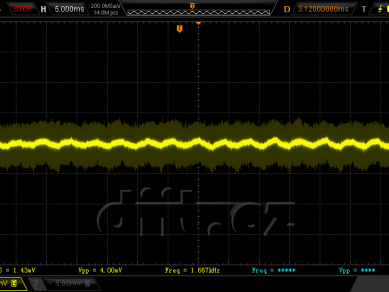
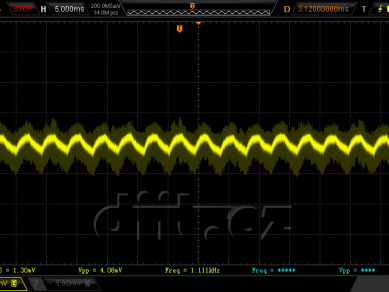
Ripple of +5 V SB, from left: 0 A, 2.42 A, 3.35 A
Load Tests
Test 1 (36.26W Load)
| Rail |
Load |
Voltage |
Ripple |
| 12V |
1.91A |
12.15V |
30.0mV |
| 5V |
0.33A |
5.22V |
24.4mV |
| 3.3V |
1.49A |
3.38V |
42.4mV |
| −12V |
0.32A |
−11.57V |
31.2mV |
| 5Vsb |
0.52A |
5.15V |
20.8mV |
| AC Power |
51.5W |
| Efficiency |
70.4% |
| Power Factor |
1.0 |
| Intake Temp |
26°C |
| Exhaust Temp |
28°C |
Test 2 (122.14W Load)
| Rail |
Load |
Voltage |
Ripple |
| 12V |
7.19A |
12.2V |
32.8mV |
| 5V |
3.52A |
5.14V |
39.2mV |
| 3.3V |
2.94A |
3.38V |
68.8mV |
| −12V |
0.32A |
−11.84V |
33.6mV |
| 5Vsb |
0.51A |
5.11V |
31.2mV |
| AC Power |
140.5W |
| Efficiency |
86.9% |
| Power Factor |
0.89 |
| Intake Temp |
26°C |
| Exhaust Temp |
34°C |
Test 3 (235.66W Load)
| Rail |
Load |
Voltage |
Ripple |
| 12V |
14.89A |
12.15V |
30.4mV |
| 5V |
6.12A |
5.09V |
40.0mV |
| 3.3V |
4.67A |
3.38V |
64.0mV |
| −12V |
0.31A |
−11.94V |
92.0mV |
| 5Vsb |
1.01A |
5.06V |
34.4mV |
| AC Power |
266.5W |
| Efficiency |
88.8% |
| Power Factor |
0.98 |
| Intake Temp |
29°C |
| Exhaust Temp |
41°C |
Test 4 (362.92W Load)
| Rail |
Load |
Voltage |
Ripple |
| 12V |
22.57A |
12.2V |
24.4mV |
| 5V |
9.48A |
5.04V |
33.6mV |
| 3.3V |
8.71A |
3.38V |
26.4mV |
| −12V |
0.32A |
−12.05V |
54.4mV |
| 5Vsb |
1.49A |
5.03V |
44.8mV |
| AC Power |
405.0W |
| Efficiency |
89.9% |
| Power Factor |
0.99 |
| Intake Temp |
30°C |
| Exhaust Temp |
47°C |
Test 5 (472.21W Load)
| Rail |
Load |
Voltage |
Ripple |
| 12V |
29.97A |
12.16V |
32.8mV |
| 5V |
11.18A |
5.0V |
64.0mV |
| 3.3V |
11.61A |
3.32V |
56.8mV |
| −12V |
0.31A |
−12.1V |
55.2mV |
| 5Vsb |
1.92A |
4.99V |
57.6mV |
| AC Power |
534.5W |
| Efficiency |
88.4% |
| Power Factor |
0.99 |
| Intake Temp |
33°C |
| Exhaust Temp |
46°C |
Test 6 (602.11W Load)
| Rail |
Load |
Voltage |
Ripple |
| 12V |
39.81A |
12.15V |
40.0mV |
| 5V |
12.47A |
5.09V |
66.4mV |
| 3.3V |
12.65A |
3.36V |
65.6mV |
| −12V |
0.32A |
−12.16V |
56.0mV |
| 5Vsb |
2.37A |
4.94V |
76.0mV |
| AC Power |
684.5W |
| Efficiency |
88.0% |
| Power Factor |
1.0 |
| Intake Temp |
35°C |
| Exhaust Temp |
53°C |
Crossload Test 1 (109.37W Load)
| Rail |
Load |
Voltage |
Ripple |
| 12V |
1.76A |
12.22V |
22.8mV |
| 5V |
1.51A |
5.12V |
24.8mV |
| 3.3V |
21.46A |
3.46V |
29.6mV |
| −12V |
0.28A |
−11.7V |
28.0mV |
| 5Vsb |
0.51A |
5.10V |
28.0mV |
| AC Power |
143.0W |
| Efficiency |
76.5% |
| Power Factor |
0.9 |
| Intake Temp |
28°C |
| Exhaust Temp |
34°C |
Crossload Test 2 (138.23W Load)
| Rail |
Load |
Voltage |
Ripple |
| 12V |
1.77A |
12.72V |
31.6mV |
| 5V |
21.65A |
4.84V |
31.2mV |
| 3.3V |
1.45A |
3.36V |
27.2mV |
| −12V |
0.29A |
−12.22V |
36.8mV |
| 5Vsb |
0.51A |
5.1V |
28.8mV |
| AC Power |
174.0W |
| Efficiency |
79.4% |
| Power Factor |
0.94 |
| Intake Temp |
28°C |
| Exhaust Temp |
34°C |
Crossload Test 3 (560.05W Load)
| Rail |
Load |
Voltage |
Ripple |
| 12V |
45.8A |
11.81V |
25.6mV |
| 5V |
1.56A |
5.27V |
35.2mV |
| 3.3V |
1.4A |
3.33V |
38.4mV |
| −12V |
0.33A |
−11.94V |
23.6mV |
| 5Vsb |
0.46A |
5.07V |
52.8mV |
| AC Power |
629.0W |
| Efficiency |
89.0% |
| Power Factor |
0.99 |
| Intake Temp |
34°C |
| Exhaust Temp |
45°C |
Overload Test (841.23W Load)
| Rail |
Load |
Voltage |
Ripple |
| 12V |
53.0A |
12.26V |
59.2mV |
| 5V |
3.29A |
4.76V |
172.0mV |
| 3.3V |
19.22A |
3.26V |
? |
| −12V |
0.29A |
−12.45V |
? |
| 5Vsb |
3.28A |
4.85V |
? |
| AC Power |
1015.0W |
| Efficiency |
82.9% |
| Power Factor |
1.0 |
| Intake Temp |
41°C |
| Exhaust Temp |
73°C |
The 12V rail had maximum and minimum values of 12.2V and 12.1V respectively, giving us 0.2V (or 1.66%) Line regulation and 0.1V (0.83%) Variation, or load regulation. The 5V rail started near the maximum allowed in ATX specs at 5.22V and dropped to 4.99V, giving us 0.22V (4.4%) Line regulation and 0.23V (4.6V) Variation. Last but not least, the 3.3V rail had maximum and minimum values of 3.38 and 3.32V respectively, giving us 0.08V (2.42%) line regulation and 0.06V (1.82%) Variation. This is a great result on the 12V rail, a good result on the 3.3V rail, and a very average result on the 5V rail.
Below 40W load, PFC controller constantly cycled between being on and off and the power meter could not accurately measure the power draw. Just under 40 W the PFC was running almost constantly and I was able to read the input power, but even then we do not guarantee the precision – the efficiency may be somewhat higher than 70 % measured. In subsequent tests it climbed over 80 % and peaked at just under 90 %. But the fan curve is oriented towards silence, rather than cooling, so the power supply runs quite hot. Over 50 °C is very high, especially with those capacitors in there.
In addition to the progressive load tests, three crossload tests were also performed. In the first test, with the 3.3V rail being loaded heavily, its voltage was high, but still just barely in spec. In the second test (with the 5V rail loaded heavily), the 12V rail went too high, and in the third test (with the 12V rail loaded heavily), the 5V rail was too high. Although this result is poor, it’s typical of group-regulated designs. I was also able to overload the power supply to about 840W – a full 240W above its rating. Under this test, the 12V rail voltage kept dropping and the unit would shut down. The voltages were in spec, but the ripple had gone through the roof on the 5V rail and the exhaust air temperature was a scorching 73°C
Ripple
| Rail |
Test 1 (36.26W) |
Test 6 (601.11W) |
| 5V |
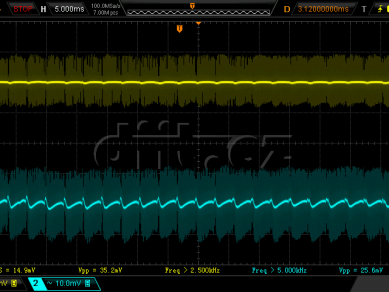 |
 |
| 3.3V |
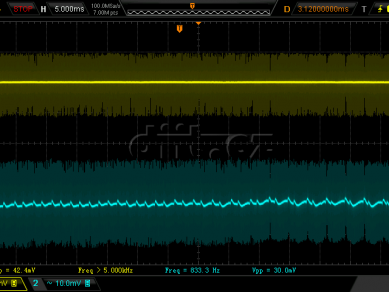 |
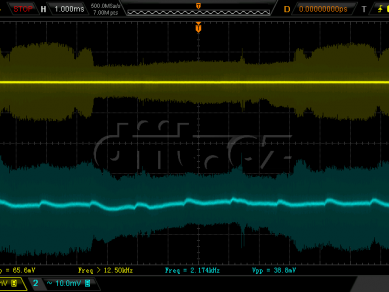 |
| −12V |
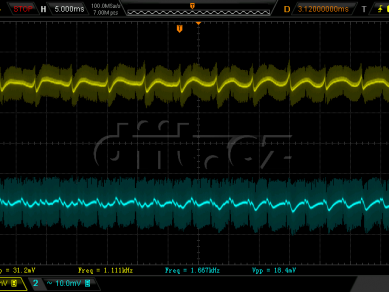 |
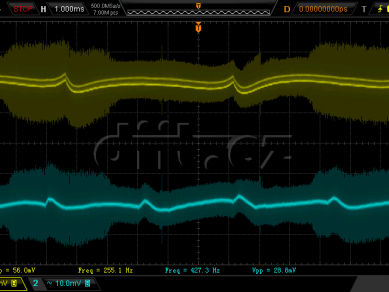 |
| 5Vsb |
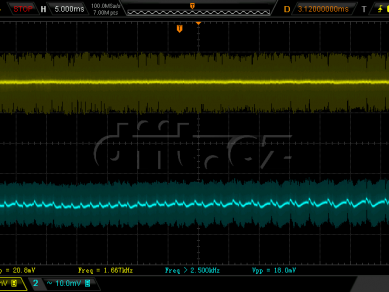 |
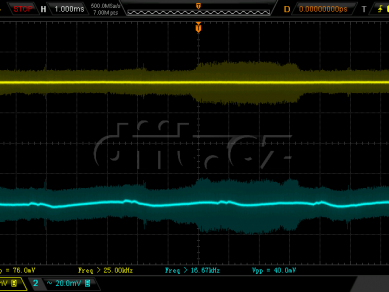 |
.
Quite a disaster. The worst is 3.3V rail (which usually powers memory modules) – besides Tests 1 and 4, it is out of spec. I found it hard to believe that Silverstone would sell a power supply with out of spec ripple like this, so we tried moving things around to rule out interference, but the source of the ripple was definitely the power supply. Other reviews (such as on TechPowerUp) have found the same problem. The 5V and 5VSB rails were also out of spec at 80% and 100% load. The 12V rail, on the other hand, had ripple below half the maximum allowed at all times. Note that these tables are a bit different to how Callum (c_hegge) did them. On these tables, the yellow waveform (CH-1) is the rail in the corresponding row in the table. The light blue waveform (CH-2) is the 12V rail on all of the shots.
Pages: 1 2 3 4












